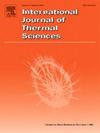Infrared camouflage based on In3SbTe2 for dynamic thermal management
IF 4.9
2区 工程技术
Q1 ENGINEERING, MECHANICAL
International Journal of Thermal Sciences
Pub Date : 2025-03-29
DOI:10.1016/j.ijthermalsci.2025.109903
引用次数: 0
Abstract
Achieving low emissivity in infrared detection bands is an effective means of infrared camouflage. However, in complex environments, the modulation of surface temperature is also crucial to improve the effectiveness of IR camouflage. In this study, a tunable multilayer thermal emitter (TMTE) is proposed to maintain the low emissivity in the infrared (IR) detection band while realizing the dynamic regulation of the radiative heat dissipation in the non-atmospheric window (NAW, 5–8 μm) by modulating the crystalline and amorphous phase transitions of the phase change material In3SbTe2 (IST). The TMTE consists of Ge/Al2O3/Ge/IST/Ag layer, which utilizes the phase transition property of IST to regulate the emissivity in the mid-wave (MWIR, 3–5 μm), long-wave (LWIR, 8–14 μm) and NAW bands. In its crystalline state the TMTE achieves high emissivity in the NAW, aiding heat dissipation when the target temperature is above the background. When the background temperature is higher than that of the target, it can be switched to the amorphous state. The TMTE at this point achieves a low average emissivity in the NAW band, in order to minimizes heat loss. Simulated thermal images of these two modes demonstrate effective IR stealth in different temperature ranges, demonstrating the potential of this TMTE for adaptable, multi-band infrared camouflage. This adjustable emissivity provides robust multi-band IR camouflage adapted to environmental conditions, offering new insights into IR stealth technology.
基于In3SbTe2的动态热管理红外伪装
实现红外探测波段的低发射率是红外伪装的有效手段。然而,在复杂的环境中,表面温度的调制对于提高红外伪装的有效性也至关重要。本研究提出了一种可调谐多层热发射器(TMTE),通过调制相变材料In3SbTe2 (IST)的结晶和非晶相变,在保持红外探测波段的低发射率的同时,实现对非大气窗口(NAW, 5-8 μm)辐射散热的动态调节。TMTE由Ge/Al2O3/Ge/IST/Ag层组成,利用IST的相变特性调节中波(MWIR, 3-5 μm)、长波(LWIR, 8-14 μm)和NAW波段的发射率。在其晶体状态下,TMTE在NAW中实现了高发射率,当目标温度高于背景温度时有助于散热。当背景温度高于目标温度时,它可以切换到非晶态。TMTE在这一点上达到低平均发射率在NAW波段,以尽量减少热损失。这两种模式的模拟热图像显示了在不同温度范围内有效的红外隐身,证明了该TMTE在适应性强的多波段红外伪装方面的潜力。这种可调节的发射率提供了适应环境条件的强大的多波段红外伪装,为红外隐身技术提供了新的见解。
本文章由计算机程序翻译,如有差异,请以英文原文为准。
求助全文
约1分钟内获得全文
求助全文
来源期刊

International Journal of Thermal Sciences
工程技术-工程:机械
CiteScore
8.10
自引率
11.10%
发文量
531
审稿时长
55 days
期刊介绍:
The International Journal of Thermal Sciences is a journal devoted to the publication of fundamental studies on the physics of transfer processes in general, with an emphasis on thermal aspects and also applied research on various processes, energy systems and the environment. Articles are published in English and French, and are subject to peer review.
The fundamental subjects considered within the scope of the journal are:
* Heat and relevant mass transfer at all scales (nano, micro and macro) and in all types of material (heterogeneous, composites, biological,...) and fluid flow
* Forced, natural or mixed convection in reactive or non-reactive media
* Single or multi–phase fluid flow with or without phase change
* Near–and far–field radiative heat transfer
* Combined modes of heat transfer in complex systems (for example, plasmas, biological, geological,...)
* Multiscale modelling
The applied research topics include:
* Heat exchangers, heat pipes, cooling processes
* Transport phenomena taking place in industrial processes (chemical, food and agricultural, metallurgical, space and aeronautical, automobile industries)
* Nano–and micro–technology for energy, space, biosystems and devices
* Heat transport analysis in advanced systems
* Impact of energy–related processes on environment, and emerging energy systems
The study of thermophysical properties of materials and fluids, thermal measurement techniques, inverse methods, and the developments of experimental methods are within the scope of the International Journal of Thermal Sciences which also covers the modelling, and numerical methods applied to thermal transfer.
 求助内容:
求助内容: 应助结果提醒方式:
应助结果提醒方式:


